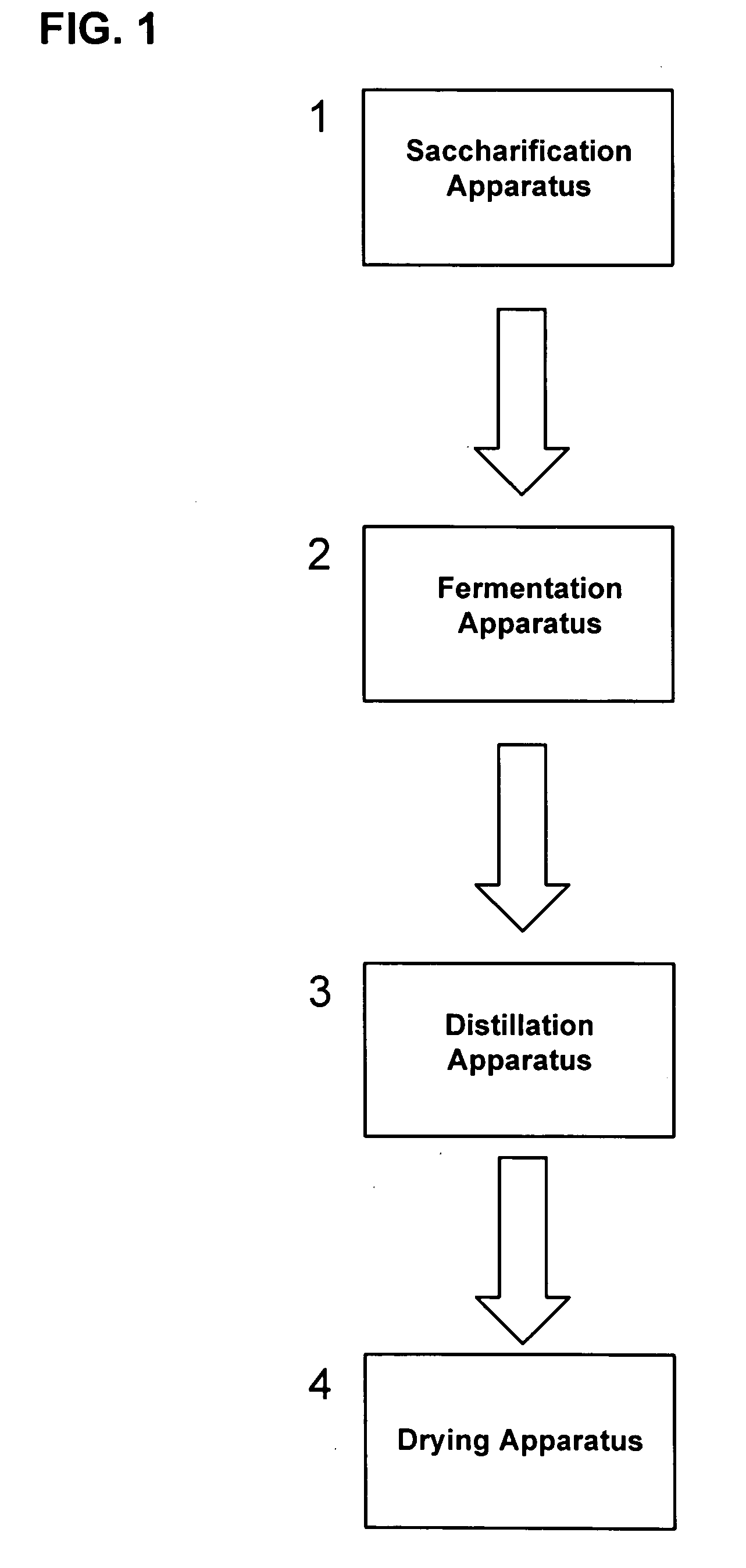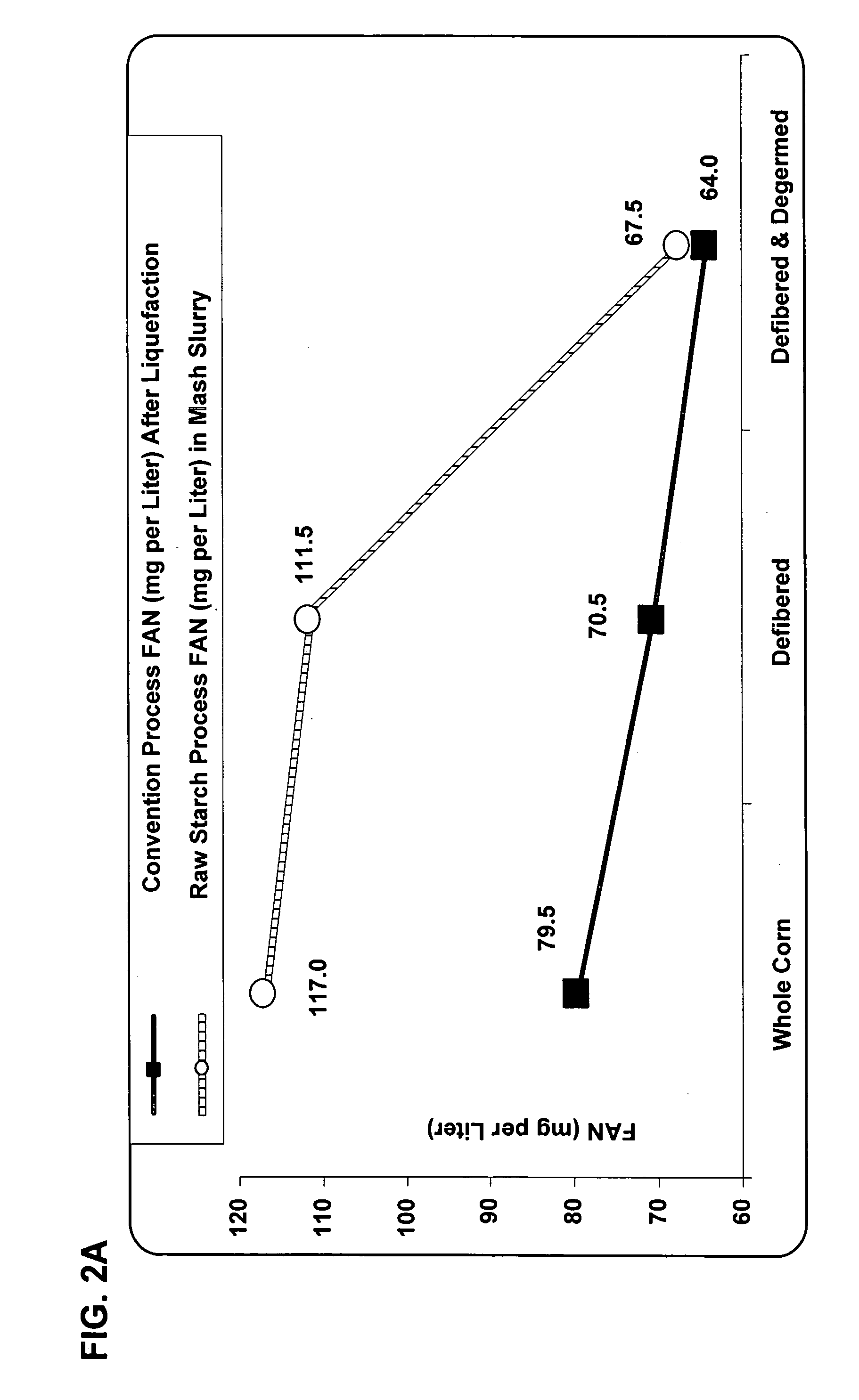Methods and systems for producing ethanol using raw starch and fractionation
a technology of raw starch and ethanol, which is applied in the field of methods and systems for producing ethanol using raw starch and fractionation, can solve the problems of numerous inefficiencies of methods, and achieve the effect of high alcohol content and high alcohol beer production
- Summary
- Abstract
- Description
- Claims
- Application Information
AI Technical Summary
Benefits of technology
Problems solved by technology
Method used
Image
Examples
example 1
The Present Process Provides Improved Efficiency with Substrates Derived from Grain Dry Milling Operations (Endosperm, Fiber, & Germ)
[0145] The present invention provides an improved method for fermenting substrates derived from grain milling (dry fractionation) processes. The present process is useful for endosperm fermentation since FAN levels in the mash are reduced to the removal of germ. The present process contributes to the endogenous enzymes activity in the grain. Dramatic increase in FAN in whole corn and defibered corn fermentations are reached compared to the initial mash slurry.
Results and Discussion
[0146] The present process is useful for endosperm fermentation since FAN levels in the mash are reduced due to the removal of germ, as shown in FIG. 2A. FAN supplies necessary nitrogen for yeast growth and reducing ethanol related stress in high gravity ethanol fermentations. FIG. 2A also reveals the negative impact of liquefaction on reducing the amount of FAN available...
example 2
The Present Method Produced High Protein DDG from Fractionated Plant Product
[0149] The present invention demonstrated that fractionation of corn prior to fermentation provides high levels of protein in the resulting DDG.
Materials and Methods
[0150] Corn was fractionated prior to fermentation through use of a Satake fractionation system. After fractionation, the corn was fermented according to the present invention employing for saccharification glucoamylase and acid fungal amylase without cooking. The fermentation was conducted at 90° F. and at a pH of 5. After the corn solids were fermented, the ethanol was distilled out. The remaining solids were then dried, and samples of fiber, germ, and starch were taken. All fractionation samples were ground for twenty seconds on a Knifetec. These samples were then analyzed for starch, protein, fat, and neutral detergent fiber content. The percent ethanol yield was also calculated for each sample. See also the Materials and Methods sections...
example 3
The Present Process Provided Improved Corn Fiber Fermentation
[0152] The present invention provides an improved method for fermenting corn fiber substrates derived from grain milling (dry fractionation) processes. The present process was useful for gentler removal of starch from corn fiber fractions via fermentation. Typically, corn fiber fractions contain recalcitrant starch deposits. The present method provided improved access to the starch present in the corn fiber.
Materials and Methods
[0153] Final fiber obtained from Broin Enterprises, Inc. (BEI) in Scotland, S. Dak. U.S.A. was used in this experiment. The makeup water used was deionized water. The 550,000 gallon fermenters were pH adjusted to 4.5 with sulfuric acid (0.5 ml of 10× solution required). The wet fiber was ground in the Knifetech mill two times for ten seconds. A 20,000 gallon yeast propagator temperature was maintained at ninety degrees Fahrenheit (90° F.) with a propagator time of eight (8) hours and pH adjusted...
PUM
 Login to View More
Login to View More Abstract
Description
Claims
Application Information
 Login to View More
Login to View More - R&D
- Intellectual Property
- Life Sciences
- Materials
- Tech Scout
- Unparalleled Data Quality
- Higher Quality Content
- 60% Fewer Hallucinations
Browse by: Latest US Patents, China's latest patents, Technical Efficacy Thesaurus, Application Domain, Technology Topic, Popular Technical Reports.
© 2025 PatSnap. All rights reserved.Legal|Privacy policy|Modern Slavery Act Transparency Statement|Sitemap|About US| Contact US: help@patsnap.com



